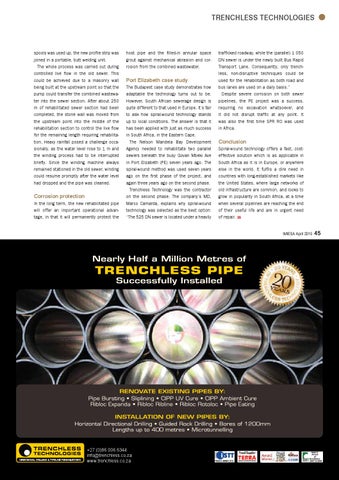TRENCHLESS TECHNOLOGIES
spools was used up, the new profile strip was joined in a portable, butt welding unit. The whole process was carried out during controlled live flow in the old sewer. This could be achieved due to a masonry wall being built at the upstream point so that the pump could transfer the combined wastewater into the sewer section. After about 250 m of rehabilitated sewer section had been completed, the stone wall was moved from the upstream point into the middle of the rehabilitation section to control the live flow for the remaining length requiring rehabilitation. Heavy rainfall posed a challenge occasionally, as the water level rose to 1 m and the winding process had to be interrupted briefly. Since the winding machine always remained stationed in the old sewer, winding could resume promptly after the water level had dropped and the pipe was cleaned.
Corrosion protection In the long term, the new rehabilitated pipe will offer an important operational advantage, in that it will permanently protect the
host pipe and the filled-in annular space grout against mechanical abrasion and corrosion from the combined wastewater.
Port Elizabeth case study The Budapest case study demonstrates how adaptable the technology turns out to be. However, South African sewerage design is quite different to that used in Europe. It’s fair to ask how spiral-wound technology stands up to local conditions. The answer is that it has been applied with just as much success in South Africa, in the Eastern Cape. The Nelson Mandela Bay Development Agency needed to rehabilitate two parallel sewers beneath the busy Govan Mbeki Ave in Port Elizabeth (PE) seven years ago. The spiral-wound method was used seven years ago on the first phase of the project, and again three years ago on the second phase. Trenchless Technology was the contractor on the second phase. The company’s MD, Marco Camarda, explains why spiral-wound technology was selected as the best option: “The 525 DN sewer is located under a heavily
trafficked roadway, while the (parallel) 1 050 DN sewer is under the newly built Bus Rapid Transport Lane. Consequently, only trenchless, non-disruptive techniques could be used for the rehabilitation as both road and bus lanes are used on a daily basis.” Despite severe corrosion on both sewer pipelines, the PE project was a success, requiring no excavation whatsoever, and it did not disrupt traffic at any point. It was also the first time SPR RO was used in Africa.
Conclusion Spiral-wound technology offers a fast, costeffective solution which is as applicable in South Africa as it is in Europe, or anywhere else in the world. It fulfils a dire need in countries with long-established markets like the United States, where large networks of old infrastructure are common, and looks to grow in popularity in South Africa, at a time when several pipelines are reaching the end of their useful life and are in urgent need of repair. IMIESA April 2015
+27 (0)86 006 6344 info@trenchless.co.za www.trenchless.co.za
45
